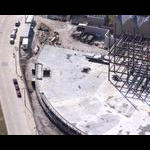 Last Wednesday afternoon was sunny and mild and a perfect day to wander the concrete slab of the ground floor of the Eckstein Hall construction site, below the steel beams that hint at this great building, and imagine the spaces where Marquette law teachers and students will read and write, discuss, dine and generally enjoy one another’s intellect and company. For some reason, the construction site reminded me of years ago being on the playing field at a totally deserted Michigan Stadium in Ann Arbor; on that day, an awesome silence permitted the perfect imagining of the awesome roar of the packed stadium.
Last Wednesday afternoon was sunny and mild and a perfect day to wander the concrete slab of the ground floor of the Eckstein Hall construction site, below the steel beams that hint at this great building, and imagine the spaces where Marquette law teachers and students will read and write, discuss, dine and generally enjoy one another’s intellect and company. For some reason, the construction site reminded me of years ago being on the playing field at a totally deserted Michigan Stadium in Ann Arbor; on that day, an awesome silence permitted the perfect imagining of the awesome roar of the packed stadium.
I should be embarrassed to admit that much of my imagination has been dedicated in the last couple of years to imagining Eckstein Hall. I have driven every ramp of the Marquette Interchange in an effort to envision how it will appear to the hundreds of thousands of people who will pass by it daily (yes, literally hundreds of thousands daily). When and how will drivers see its complex sweep of brick, metal, and (mostly) glass? Will they note the substantial columns behind the glass curtain wall, meant to show that Eckstein Hall soars as well as sweeps? Will the building be bold, maybe even heroic, and beautiful?
The architects see lines on paper and understand how the façade will look; they see the lines and feel the volume of the spaces. But a neophyte like me needed to walk the concrete slab, floor plans in hand, and stand below the beams, in order to imagine the bustle in the building’s forum, a debate in the appellate courtroom, and the chatter of voices and clinking of plates in the café. In order to imagine the awesome roar of this new law school building packed with activity.
Throughout the winter, Eckstein Hall, the future home of the Law School, was being built out of concrete, down into the soil of Tory Hill. In the past few weeks, we have begun to see Eckstein Hall rising, the first parts of its steel structure suggesting its ultimate size.
Watching Eckstein Hall take shape, it occurred to me that humans begin as soft tissue, with a hard skeleton developing even after birth. Buildings, it seems, are the opposite. Buildings start hard and then soften as they add the elements that make them a pleasure to see and inhabit. It is a matter of balance, these hard and soft elements.
To give one example of the balance we are seeking in Eckstein Hall, the building’s freeway façade will be grand and complex. But most of this most public face will be transparent glass, so that passersby can glimpse the human activity within. They will see students and teachers in courtrooms and classrooms, and in the conference center and public service offices they will see their fellow citizens and maybe, one day, themselves. They will see, we hope, a building that is at once a forceful presence and an inviting presence-hard with purpose and tradition, and soft with transparency and opportunity.
